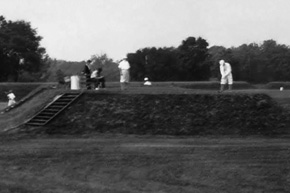NEWARK
THE OCTAGON'S MODERN HISTORY

The walls of the Avenue and Octagon gateway in 1911, when the golf course was first being set up within the earthworks.
When pioneers began to settle around Newark in the late 1700s, the earthworks were already ancient and overgrown. Local Indians,
many just recently arrived in Ohio themselves, knew or told little about them. From the beginning, the mystery and size
of the works fascinated some Newark citizens and visitors, but many people only wanted to loot the mounds, or cut them
down to build houses or factories.
The only reason two major parts of the earthworks survived is that they were adaptable to entertainment: The Great Circle
became the Licking County Fairground from 1854 to 1933. The Ohio State Militia encamped at the Circle and Octagon for
a few years around 1900, and the land was leased as a private golf course by 1910.
Although the surviving sections today are officially public state memorials, the Moundbuilders Country Club holds a
lease for the Circle and Octagon that extends to the year 2078. Controversy over access and ownership continues to
swirl around these ancient geometric earthworks, the grandest and most impressive remaining in all of North America.
Visiting the Octagon Earthworks today raises the question: why is this still a golf course? Itís a long and complex story,
beginning in the 19th century when the citizens of Newark decided to preserve the Octagon, and offered it to the State
of Ohio as a National Guard Camp. But by 1907, it was back in local hands, and the search was on for other ideas on how
to preserve the site. Historian Dick Shiels explains that there were two main suggestions. The first was to make
it a park, supported by public funds:
But the second proposal came from a group of men who said, ďIf youíll let us build a golf course there, we will (this is
what they said in the paper) keep it open to the public at all times.Ē The editorial in the Newark Advocate said, ďLetís
make it a park.Ē The mayor said as loudly as he could, ďLetís make it a park.Ē But the vote went the other way. And
beginning then the next summer, the summer of 1911, there was a country club, or golf course at any rate, that quickly became
the Moundbuilders Country Club. Itís been just 100 years that the country club has occupied that site.
Because the Ohio Historical Society has continued to lease the land to the Moundbuilders Country Club, public access is
restricted while golf is being played. The Club claims that it has maintained the land with care, and that without the golf
course, development would probably have destroyed the earthworks long ago. But pressure has grown to open the earthworks
more fully to the public.
Barbara Crandell, a woman of Cherokee heritage, was arrested in 2002 when she went to pray at the Observatory Mound during
golf play. She explains why she was willing to risk arrest, the ancestral connection she feels to the earthworks:
They built these things so we would remember who we are. Donít lose track of who you are! When I go to the mounds, I feel
a great welling up of pride and love for my people. I love my ancestors. I love their bones. Thatís the way I was brought
up. I have great reverence for them. And every one of those mounds, I know their hands lovingly gathered the dirt, and put
it there. And I can feel their hands patting me, when I go there. So thatís why I think it was left as a trail for native
people to follow. Go there and connect with your ancestors, so you can walk a good path. It is terrible that people are
not allowed to go to these places. I mean, theyíre not just for Indian people. I mean, I connect with them, maybe in a
different way. But all peoples should be able to go there. They should be able to go there and see this wonderful sight.
And Iíd like to have it open for everybody.


